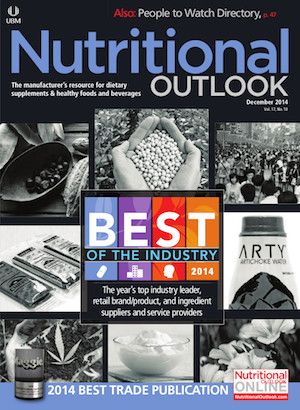Nutritional Outlook's Best of 2014: Flax Council of Canada
An approved flax/cholesterol health claim is just one of the council’s 2014 highlights.

In the pantheonof “superfoods,” you won’t find one with a more storied past than flax. Domesticated as early as the Neolithic Era, flax merited mention for its healing properties in Greek and Roman texts dating back to 650 BC, and the 8th-century emperor Charlemagne so valued the crop’s healthfulness that “he passed regulations related to a requirement for flax consumption,” says Kelley C. Fitzpatrick, director of health and nutrition, Flax Council of Canada (FCC; Winnipeg, MB).
But while flax’s backstory may be catnip to history buffs, it’s the superfood’s future that occupies the FCC. And 2014 saw the emergence of several exciting developments that demonstrate not only flax’s functional promise, but the FCC’s active role in helping realize it.
As Fitzpatrick says, “We know that consumers are looking toward real, whole foods for their nutritional needs.” As such, they’re setting their sights on flax-and, in particular, its seeds-as rich sources of soluble and insoluble fiber, the short-chain omega-3 fatty acid alpha-linolenic acid (ALA), and lignans, which Fitzpatrick describes as “a major class of phytoestrogens and an effective antioxidant.”
Now more than ever, flaxseed’s appeal is expanding beyond its traditional audience of natural and health-food devotees and “gaining traction with consumers of mass-market and convenience foods,” she continues.
Of course, flax’s profile didn’t rise this high on its own. Credit goes to the FCC’s advocacy and to the attention the group has called to the science supporting flax’s health benefits. “We know that science is very important in the promotion of healthy ingredients,” Fitzpatrick points out. “And positive research results show that flax’s highest value position is as part of the human diet to prevent several diseases and chronic conditions.”
The best place to dive into that research is the Flax Research Database for Human Health and Nutrition, which the FCC launched in partnership with Glanbia Nutritionals (Fitchburg, WI) in 2012. With their goal of making the database the most comprehensive portal for nutritional information about flax, the partners offer it free of charge to the public and update it regularly-courtesy of funding from Glanbia-to reflect the state of flax science.
The database provides an unbiased review of research on everything from omega-3s and fiber to antioxidants and proteins. As it now stands, “there are currently over 1,000 abstracts with editorial comments included,” says Fitzpatrick. Most focus on human clinical trials related to health and disease reduction, and a strict requirement that all literature be peer reviewed and available through commonly used scientific search sites helps maintain the collection’s rigor.
“We’ve also included papers highlighting analytical assessments, food formulation, and review articles,” Fitzpatrick adds, noting that the database’s audience comprises health professionals, food-industry members-even consumers. As for their response: “We’ve had very positive comments.”
Among the lessons visitors might have learned from their review of the database:
- Flaxseed’s lignans may protect against some cancers, including prostate, breast, lung, and colon, because of their antioxidant action and “ability to reduce tumor number and blood-vessel growth,” Fitzpatrick says.
- Flaxseed’s lignans and ALA help reduce and prevent inflammation that can affect the immune response. “Thus,” Fitzpatrick says, “flaxseed may be useful in the treatment of such immune disorders as rheumatoid arthritis and psoriasis.”
- A prospective, double-blind, placebo-controlled, randomized trial demonstrated reductions in systolic and diastolic blood pressure in flax-consuming subjects relative to those receiving a placebo. The higher the baseline blood pressure, the greater the flax-related reductions.
- Flaxseed appears to lower fasting blood glucose and glycated hemoglobin (HbA1c) levels, suggesting potential for diabetes management. And in overweight or obese pre-diabetic subjects, flaxseed intake decreased glucose and insulin levels while improving insulin use.
From the standpoint of 2014 milestones, the research with the most significant impact is that showing flaxseed’s potential to reduce the risk of heart disease by preventing the buildup of harmful deposits on artery walls. “In studies that assessed large groups of people to determine disease trends,” Fitzpatrick says, “increasing dietary ALA content corresponded to a decreased risk of stroke and heart disease. And along with fiber, lignans, and other antioxidants, ALA can reduce blood cholesterol”-a claim that this year won the support and sanction of Health Canada.
That’s because the FCC submitted a health-claim petition to Health Canada (the federal department that regulates such claims) describing the relationship between serum cholesterol reduction and flaxseed-ground, milled, or meal. The scientific substantiation for the claim totaled 1,079 references initially, which the team then shrank to 526 by eliminating duplicate studies. Finally, in accordance with Health Canada’s stringent requirements for study quality and design, the team winnowed the selection to a mere seven that they submitted to the agency.
And it worked. Health Canada’s Food Directorate announced the claim’s approval this past January. “The acceptance of the flaxseed/cholesterol-lowering relationship by a well-respected agency such as Health Canada provides support for the remarkable potential of flaxseed in health and wellness,” Fitzpatrick says. “And it’s important to note that this claim is one of only 10 allowed in Canada for foods and ingredients, which demonstrates the significant rigor that Health Canada demands of the scientific criteria.”
The claim is a tool that manufacturers can use to draw their consumers toward the benefits of flax-and the products made with it. “A health claim stated clearly on labels is a very positive step in promoting new-as well as increasing current-food use for flaxseed,” she notes. To maintain this momentum, the FCC will be attending trade shows, providing presentations at conferences, sponsoring media events, and populating the website www.healthyflax.org-“the backbone” of the FCC’s marketing campaign.
“We’ll also be visiting food and ingredient companies to provide information regarding the nutrition properties, as well the functional aspects, of flax for development purposes,” Fitzpatrick continues. Because the minimum amount of milled or ground flax needed to make the claim is 13 g (about 2 tablespoons) consumed three times daily for a total of 40 g, “we’re working with the Food Development Centre (FDC) here in Manitoba to create delicious products with enough flax to achieve the health claim,” she says.
Beyond that, the FCC plans to continue racking up the good flax news, whether related to its hypertensive effects, antioxidant characteristics, or even its protein components. “The research will continue to focus on lowering cardiovascular disease, metabolic syndrome, diabetes, and inflammatory disorders,” Fitzpatrick says. “We would expect that through more positive research results, there will be greater market pull for flaxseed-containing foods from consumers and hence a greater number of such foods fortified and marketed domestically.”
<<Previous Next>>
Photo © iStockphoto.com/Michael Hieber

HHS announces restructuring plans to consolidate divisions and downsize workforce
Published: March 27th 2025 | Updated: March 27th 2025According to the announcement, the restructuring will save taxpayers $1.8 billion per year by reducing the workforce by 10,000 full-time employees and consolidating the department’s 28 divisions into 15 new divisions.
















